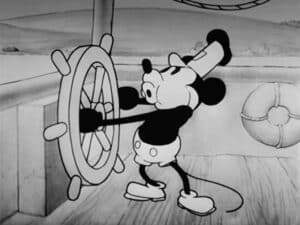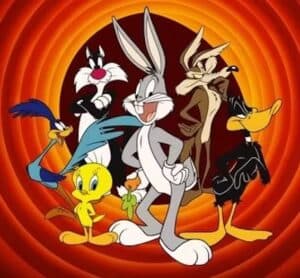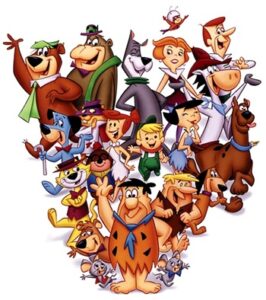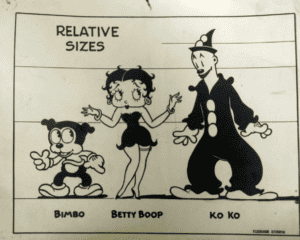With the gorgeous animation cels we’ve been handling lately, Back to the Past has been enjoying some of the best art ever drawn on celluloid. But who drew that art? Who are the animators behind the most iconic cartoons of all time? Keep reading to find out!
Side note, if you have a collection of that original art and are looking to sell it, we are more than happy to help you bring it to market!
Walt Disney, Ub Iwerks & The Nine Old Men

Mickey Mouse as he first appeared in “Steamboat Willie”
The entire multi-media empire that is the Walt Disney Corporation grows from the work of these eleven men. Disney and Iwerks split from Universal Pictures in 1928 to strike out on their own, creating Mickey Mouse as their first new character. Mickey’s third appearance, Steamboat Willie, was the first cartoon ever to be synced with sound and proved an immediate hit. This lead to an expansion of their fledgling studio, ultimately leading to the hiring of the animators Walt eventually dubbed “The Nine Old Men”. The name was initially a mocking reference to the Supreme Court, though it grew increasingly descriptive over the years.
Though Iwerks quit Disney in 1930, Milt Kahl, Marc Davis, Frank Thomas, Eric Larson,Ollie Johnston, Woolie Reitherman, Les Clark, Ward Kimball, and John Lounsbery quickly became the core of Walt Disney Studios. They cut their teeth on Silly Symphonies and other short cartoons before helping to launch Disney’s feature length animation with Snow White in 1937. The basis for just about everything beloved about the Walt Disney brand came from a combination of Walt’s visionary status and the Nine Old Men’s ability to make those visions reality. They would guide the animated side of Disney, in various combinations, up through 1986’s The Rescuers.
The Residents of Termite Terrace

Characters created at Termite Terrace. Look familiar?
Warner Bros. Cartoons formed a new animation unit in 1935, under the direction of twenty-seven-year-old Tex Avery. Tex had worked in animation since he was 20, but definitely lied to his new bosses about having directorial experience. His unit was housed in a tiny clapboard bungalow on the Warner lot, nicknamed Termite Terrace due to its perpetual insect infestation. It was there that Avery and his crew of animators (Chuck Jones, Bob Clampett, Sid Sutherland, Virgil Ross, and Frank Tashlin) would create new characters for the existing Merrie Melodies and Looney Tunes series.
Their creations included Porky Pig, Elmer Fudd, Tweety Bird, Daffy Duck, and – above all – Bugs Bunny! Needless to say, the residents of Termite Terrace quickly became the guiding light of all Warner Bros. Cartoons. It is their style that continues to define the Looney Tunes nearly a century later. And even though the original office was condemned in 1940, the Looney Tunes team would continue to be known as “Termite Terrace” into the 1960s.
Bill Hanna and Joe Barbera

Just a handful of Hanna-Barbera Originals
Bill Hanna and Joe Barbera met in 1937 while working as animators for MGM. Their first major collaboration debuted in movie theaters in 1940, a short entitled “Puss Gets the Boot”. It introduced MGM’s first hit animated character: Tom and Jerry. Hanna and Barbera would go on to create 114 shorts starring the cat and mouse duo for the studio, racking up several Oscar wins for best animated short along the way. They might would have spent their whole careers with MGM had the studio not decided to shutter its animation department in 1957. With theatrical shorts on their way out and TV syndication on the way in, MGM felt they already had a large enough backlog to capitalize on.
So, Hanna and Barbera kept working together and founded their own studio. They had some immediate successes in Saturday morning cartoons, but their first big hit came was 1960’s primetime sitcom The Flinstones. Hanna-Barbera Cartoons, Inc. would remain a top name in TV animation into the 1990s with hits like the Yogi Bear Show, The Jetsons, Johnny Quest, Super Friends, The Smurfs, and the Scooby Doo franchise. How’s that for a second act?
Max Fleischer

Fleischer Studios’ original stars Bimbo, Betty Boop, and Koko The Clown.
Max Fleischer began his career in animation in 1917, when Walt Disney was still in high school. In those days, animation was a brand-new art form and very rough. The resulting cartoons were stiff and jerky. Fleischer invented a device he called the rotoscope to help fix that. It projected a live-action filmed image onto a transparent easel, allowing an animator to faithfully recreate the steps of movement. This gave Fleischer’s first series, Out of the Inkwell, used the technique to great effect. Walt Disney’s first feature, Snow White and the Seven Dwarves, made extensive use of rotoscoping (once Fleischer’s patent expired). Even though the technology behind it has changed, the technique is still in use by animators today.
That alone is a heckuva legacy, but Max founded his own animation studio in 1929. Fleischer Studios, Inc would go on to produce popular cartoons starring original creation Betty Boop and comic characters like Popeye and Superman. While not as big a name as Disney, Fleisher’s immediately recognizable style continues to influence animators today. In fact, the creators behind the hit video game and animated series Cuphead cite him as their “true north”!
And So Many More
Animation is, at its heart, a collaborative medium. Young animators cut their teeth doing grunt work before getting a chance to do their own thing. For example, Bruce Timm was drawing background for Tiny Toons Adventures just one year before he redefined action cartoons with Batman: The Animated Series. Each of the legends above worked with a team, and those teams went on to become legends who worked with a team, et cetera on down the line.
Each of those teams produced thousands of celluloid sheets of beautiful artwork. And we are very proud to have a gorgeous collection of it coming up for sale now in our brand new virtual gallery, GoBackToThePast.Shop! And if we missed your favorite animator, let us know in the comments or on social media @b2pcollect!








